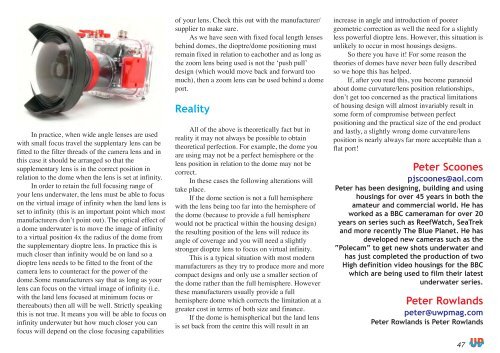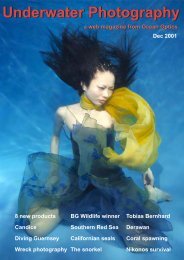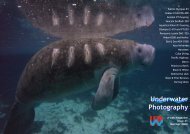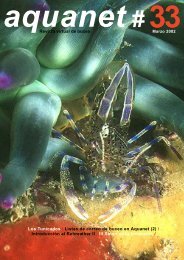Underwater Photography - SENSACIONES.org
Underwater Photography - SENSACIONES.org
Underwater Photography - SENSACIONES.org
You also want an ePaper? Increase the reach of your titles
YUMPU automatically turns print PDFs into web optimized ePapers that Google loves.
In practice, when wide angle lenses are used<br />
with small focus travel the supplentary lens can be<br />
fitted to the filter threads of the camera lens and in<br />
this case it should be arranged so that the<br />
supplementary lens is in the correct position in<br />
relation to the dome when the lens is set at infinity.<br />
In order to retain the full focusing range of<br />
your lens underwater, the lens must be able to focus<br />
on the virtual image of infinity when the land lens is<br />
set to infinity (this is an important point which most<br />
manufacturers don’t point out). The optical effect of<br />
a dome underwater is to move the image of infinity<br />
to a virtual position 4x the radius of the dome from<br />
the supplementary dioptre lens. In practice this is<br />
much closer than infinity would be on land so a<br />
dioptre lens needs to be fitted to the front of the<br />
camera lens to counteract for the power of the<br />
dome.Some manufacturers say that as long as your<br />
lens can focus on the virtual image of infinity (i.e.<br />
with the land lens focused at minimum focus or<br />
thereabouts) then all will be well. Strictly speaking<br />
this is not true. It means you will be able to focus on<br />
infinity underwater but how much closer you can<br />
focus will depend on the close focusing capabilities<br />
of your lens. Check this out with the manufacturer/<br />
supplier to make sure.<br />
As we have seen with fixed focal length lenses<br />
behind domes, the dioptre/dome positioning must<br />
remain fixed in relation to eachother and as long as<br />
the zoom lens being used is not the ‘push pull’<br />
design (which would move back and forward too<br />
much), then a zoom lens can be used behind a dome<br />
port.<br />
Reality<br />
All of the above is theoretically fact but in<br />
reality it may not always be possible to obtain<br />
theoretical perfection. For example, the dome you<br />
are using may not be a perfect hemisphere or the<br />
lens position in relation to the dome may not be<br />
correct.<br />
In these cases the following alterations will<br />
take place.<br />
If the dome section is not a full hemisphere<br />
with the lens being too far into the hemisphere of<br />
the dome (because to provide a full hemisphere<br />
would not be practical within the housing design)<br />
the resulting position of the lens will reduce its<br />
angle of coverage and you will need a slightly<br />
stronger dioptre lens to focus on virtual infinity.<br />
This is a typical situation with most modern<br />
manufacturers as they try to produce more and more<br />
compact designs and only use a smaller section of<br />
the dome rather than the full hemisphere. However<br />
these manufacturers usually provide a full<br />
hemisphere dome which corrects the limitation at a<br />
greater cost in terms of both size and finance.<br />
If the dome is hemispherical but the land lens<br />
is set back from the centre this will result in an<br />
increase in angle and introduction of poorer<br />
geometric correction as well the need for a slightly<br />
less powerful dioptre lens. However, this situation is<br />
unlikely to occur in most housings designs.<br />
So there you have it! For some reason the<br />
theories of domes have never been fully described<br />
so we hope this has helped.<br />
If, after you read this, you become paranoid<br />
about dome curvature/lens position relationships,<br />
don’t get too concerned as the practical limitations<br />
of housing design will almost invariably result in<br />
some form of compromise between perfect<br />
positioning and the practical size of the end product<br />
and lastly, a slightly wrong dome curvature/lens<br />
position is nearly always far more acceptable than a<br />
flat port!<br />
Peter Scoones<br />
pjscoones@aol.com<br />
Peter has been designing, building and using<br />
housings for over 45 years in both the<br />
amateur and commercial world. He has<br />
worked as a BBC cameraman for over 20<br />
years on series such as ReefWatch, SeaTrek<br />
and more recently The Blue Planet. He has<br />
developed new cameras such as the<br />
“Polecam” to get new shots underwater and<br />
has just completed the production of two<br />
High definition video housings for the BBC<br />
which are being used to film their latest<br />
underwater series.<br />
Peter Rowlands<br />
peter@uwpmag.com<br />
Peter Rowlands is Peter Rowlands<br />
47
















